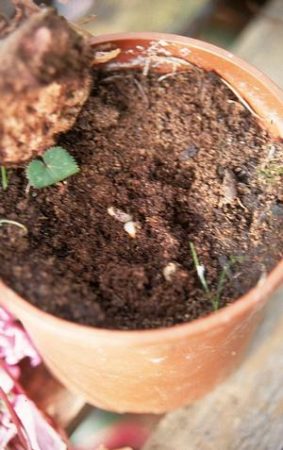Post category: Vine weevil
The adult vine weevil – a dark brown round-backed beetle-like insect – eats U-shaped pieces from the edge of leaves of shrubs, especially rhododendron, bergenia, euonymus and pieris, earning it the nickname of ‘ticket collector’. This damage, usually near the ground, is not significant but it is an indication of the presence of the pest.

Vine weevil larvae on cyclamen
Where there are signs of adult damage, the chances are that the white, C-shaped grubs are active below soil level. These cause severe damage by eating the roots of many kinds of plant, especially fleshy-rooted plants.
Rhododendron, strawberries, grapes, cyclamen, primula, begonia, sempervivums, saxifrages, camellias and potted plants are commonly affected. The damage to woody plants occurs usually at the neck of the plant where the bark is eaten away.
Vine weevils are more active in the warm soil of pots and greenhouses. Virtually unknown twenty five years ago, they have been spread to gardens in plant pots. Affected plants show poor growth and often wilt, though well supplied with moisture, before dying.
Damage is usually most severe when plants are grown in pots filled with peat based compost and when peat is used in the planting hole outdoors. Mixing unsterilised garden soil, half and half, with peat-based compost greatly reduces the numbers of grubs in pots because it introduces the natural predators and parasites of the vine weevil eggs and grubs. Always thoroughly mix peat with the garden soil outdoors for the same reason.
Check the roots of new plants for grubs. Clear all debris to reduce hiding places for the flightless, nocturnal-feeding, adult weevils. Provado is effective used in the compost.
Parasitic eelworms are available on order from garden centres and by post. These attack the grubs, but there must be a low level population of grubs already present before application and soil temperature levels must be at least 12º Celsius, which is common in a greenhouse but reached outdoors only in the summer months. The eelworm remedy is best applied in late July or August.


